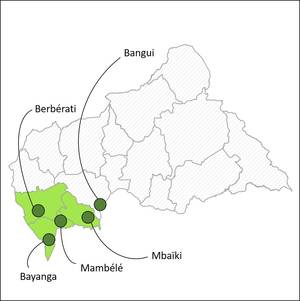Central African Republic
The Central African Republic (CAR) has great natural potential in terms of its arable land suitable for agriculture, pasture, and rangelands, and diverse forests types – ranging from dense humid forest in the South to savannah in the North – providing timber, firewood, non-timber forest products (NTFPs), etc. These natural resources, along with the associated environmental and economic services they deliver to the local populations, are threatened by unsustainable practices (e.g. slash-and-burn agriculture, firewood extraction, bushfires mostly linked to bushmeat hunting, etc.). The extent of the forest and landscape degradation is not yet known precisely, but the rate of deforestation (0.17 percent between 2000 and 2010 for the 13 Southern Prefectures of the CAR, twice the rate of the global level between 2010 and 2015) indicates there is a significant pressure on forests in particular, and landscapes in general.
Forest and landscape restoration (FLR) activities are of particular relevance to the CAR, which has been suffering from decades of instability and sluggish growth, with the last crisis in 2013 being the most critical. The vast majority of local populations suffer from extreme poverty and food insecurity and their livelihood is highly dependent on natural resources.

IMPACTS
The CAR project, under the global programme The Restoration Initiative (TRI), shares TRI’s objectives for “Biodiversity conservation, protection of climate and other ecosystem services through [the] restoration of critical landscapes in the CAR and complementary sustainable land management (SLM).”
The project is structured into four interlinked components:
- policy development and integration;
- implementation of restoration programmes and complementary initiatives;
- capacity building and finance mobilization; and
- knowledge sharing and partnerships.
For more information of FLRM activities, click here:
- TRI project in the Central African Republic
- Launch of TRI Global Programme
- TRI: joining forces on FLR

